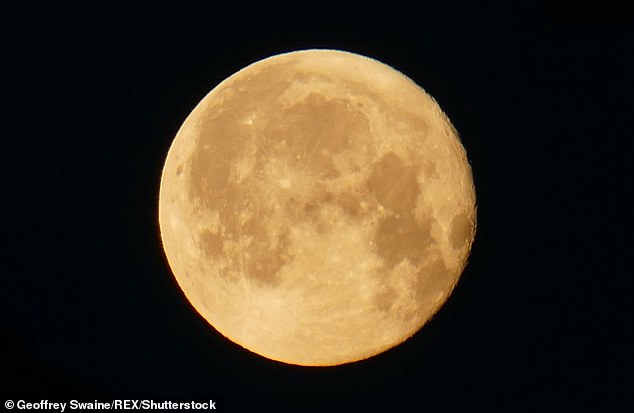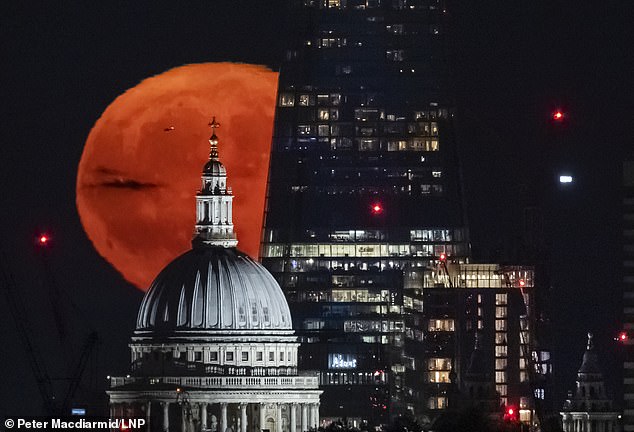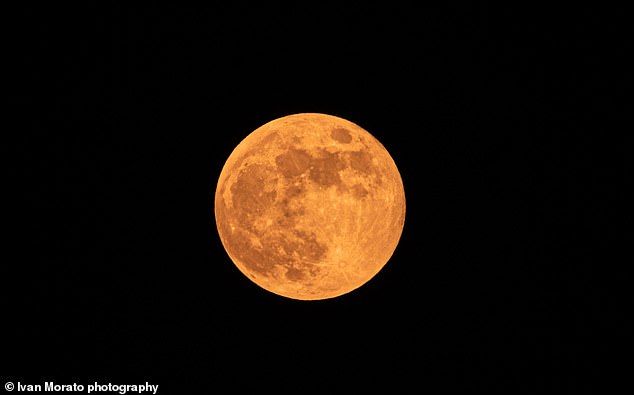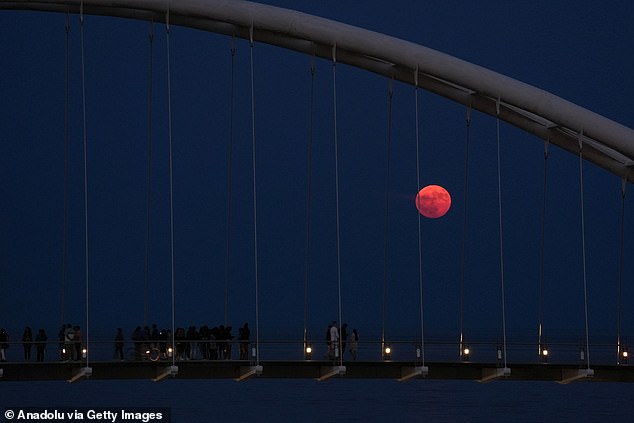If you love skygazing, you won’t want to miss a rare viewing opportunity tonight – and you should be able to catch it before you go to bed.
According to astronomers, the Full Strawberry Moon will be lower in the sky than any full moon since 2006.
A Strawberry Moon is simply the full moon when it appears in June.
This year, it will coincide with a rare celestial phenomenon called the ‘major lunar standstill’ which makes the moon appear lower.
It should be visible as long as you’re in the Northern Hemisphere – but the further north you are, the closer to the horizon the moon will seem.
‘The moon will appear unusually low on the southern horizon,’ Dr Robert Massey, deputy executive director of the Royal Astronomical Society, told MailOnline.
‘It will appear very dramatic, especially in northern parts of the UK.’
Here’s everything you need to know about the rare celestial event.

The Strawberry ‘supermoon’ rises up in the hazy evening sky from behind St Michael’s Tower on Glastonbury Tor in Somerset, June 2021

Strawberry Moon is simply the full moon when it appears in June – but this year it will be lower on the horizon than normal. Pictured, the Strawberry Moon in June 2024
What is the Strawberry Moon?
Strawberry Moon is simply the name traditionally given to the full moon when it appears in the month of June.
But it’s a common misconception that the name ‘Strawberry Moon’ refers to the moon’s colour or any kind of resemblance to the popular summer fruit.
Whenever the full moon appears, it is given a nickname depending on the month of the year – a tradition that goes back hundreds of years.
So January is Wolf Moon, February is Snow Moon, March is Worm Moon, April is Pink Moon, May is Flower Moon and so on.
June’s full moon is known as Strawberry Moon because it historically appeared when the strawberry harvest first took place.
Will the moon be lower than usual?
The June full moon will be lower than usual this year due to an astronomical phenomenon called ‘major lunar standstill’.

Pictured, the Strawberry Moon rises over St Paul’s Cathedral and The Shard in central London on June 22, 2024. This year it will be even lower

June full moon (Strawberry Moon) will be lower than usual this year due to an astronomical phenomenon called ‘major lunar standstill’. Pictured, Strawberry Moon of 2020, as seen from Spain
Occurring about once every 18.6 years, a major lunar standstill is when moonrise and moonset are furthest apart along the horizon, as viewed from Earth.
It means the moon appears unusually low in the horizon and the sun unusually high in the Northern Hemisphere.
At the same time, the moon appears unusually high and the sun unusually low in the Southern Hemisphere.
Major lunar standstill actually lasts for a period of roughly two years, which is why we saw a very low Strawberry Moon this time last year, but this month it’ll be lower.
This week marks the lowest a full moon has been in the sky since 2006 – and it won’t be this low again until 2043.
According to Dr Massey, the best time to see the event is simply when the moon rises – which in London is 21:18 BST tonight and at 22:20 BST tomorrow night – meaning you won’t have to camp out all night for this one.
The website Time and Date lets you search for a specific location and see exactly when the moon rises in your area.
It’s worth noting the moon will be lower the further north you are – so it will be especially low in places like northern Scotland and the Shetland Islands.

Major lunar standstill actually lasts for a period of two years, which is why we saw a very low Strawberry Moon this time last year. Pictured, Strawberry Moon rises over Humber Bay Arch Bridge in Toronto, Ontario, June 21, 2024
How will the moon look different?
The moon will appear to take on different coloured hues, although this is a trick of the light and usually depends on how low it is on the horizon.
‘A red or yellow colored moon usually indicates a moon seen near the horizon,’ NASA says.
‘There, some of the blue light has been scattered away by a long path through the Earth’s atmosphere, sometimes laden with fine dust.
‘A blue-colored moon is more rare and can indicate a moon seen through an atmosphere carrying larger dust particles.’
But the moon may also appear slightly bigger.
When the moon is especially close to the horizon, our brains experience something called the ‘Moon Illusion’,
The optical illusion causes the moon to appear bigger compared to when it’s higher in the sky (although scientists still aren’t sure why or how it works).
What’s the forecast like?
According to the latest update from the Met Office, the clearest, cloud-free skies tonight will be in the north of Britain.
‘It will be dry for most tonight, with variable cloud and clear spells,’ Met Office spokesperson Andrea Bishop told MailOnline.
‘Western parts will tend to cloud over later, with some low cloud and fog patches likely in the south where it is mild.’
if you don’t get a chance to see the Strawberry Moon tonight, you’ll get another chance on Wednesday night, but conditions won’t be as good.
‘Wednesday will be a cloudier night than Tuesday, with the east hopefully staying dry with clear spells,’ said Bishop.
‘Showers will affect some western and then central areas though, followed by a more organised area of thundery rain, which may be heavy, moving erratically north across western areas overnight, which may affect visibility.’
